Soon after the fall of Corregidor in May 1942, with the surrender of 11,000 United States troops there and 50,000 elsewhere in the Philippines, the Japanese planned to attack Port Moresby. They proposed an assault overland across the Owen Stanleys, combined with a sea-borne attack from Rabaul. These forces were to be protected by an airfield at Milne Bay, which was to be captured, and by the airstrip being built on Guadalcanal.
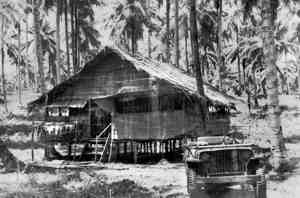
Like to copy this image? Please click here first
AWM 148944 Milne Bay, 1942. The Command Post at Headquarters, 7th Infantry Brigade, built among coconut palm trees on stilts with thatch roof, in traditional native style.
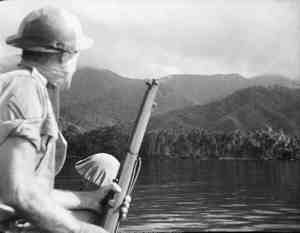
Like to copy this image? Please click here first
AWM 013315 Milne Bay, 1942. This is typical of the country around where Australian Militia Forces repulsed Japanese attempts to land.
This move began with landings at Gona and Buna in July. On 23 July, the enemy forces moving inland clashed near Awala with the Papuan Infantry Battalion and the 39th Militia Battalion. The Australians, resisting bitterly, were thrust back through Oivi, Kokoda and Deniki. By 14 August, a withdrawal to Isurava was underway.
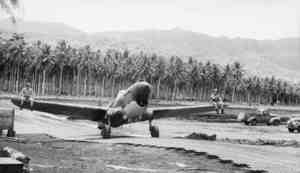
Like to copy this image? Please click here first
AWM 013329 Milne Bay, 1942. A Curtiss P40 Kittyhawk fighter aircraft from an RAAF squadron that played a big part in repelling the Japanese attack on Milne Bay. Ground crew sit on the wing tips to guide the pilot who could not see over the nose while taxiing on the pierced steel plating (psp) runway. These runways had been carved out of thick coconut plantations.
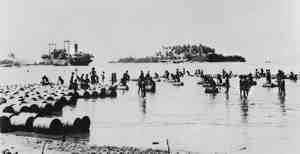
Like to copy this image? Please click here first
AWM 148937 Gili Gili, Milne Bay, 1942. Drums containing petrol being handled from ship to beach by native labour. The SS Bantam lies in the distance with a flying boat to the right of the vessel.
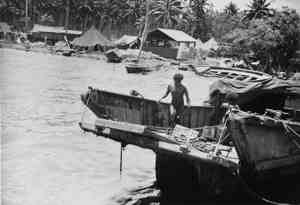
Like to copy this image? Please click here first
AWM 041282 Milne Bay. Japanese invasion barges destroyed by fighter aircraft of the Royal Australian Air Force during the Japanese landing in 1942
In the meantime, Australian Headquarters had decided to build an airfield at Milne Bay, and to garrison the area in anticipation of attack. General MacArthur’s plan was for a defensive front.

Like to copy this image? Please click here first
AWM 013317 Milne Bay, 1942. Australian troops advancing through the jungle. This is typical of the country in which the battle for Milne Bay was fought.
The 7th Militia Brigade was sent to Milne Bay and was followed on 25 July by No. 75 and No. 76 Royal Australian Air Force Squadrons, with Kittyhawks. Advance parties of the 18th Brigade A.I.F. and a battery of the 2/5th Field Regiment arrived on 12 August.
At Milne Bay, on the extreme eastern tip of Papua, a Japanese convoy with two transports carrying 2,000 marines, was attacked by air, but most Japanese troops landed. An additional 700 arrived later.
There was heavy fighting mainly for the airstrips that were strongly defended by the Australian units. An Australian counterattack from 1 September drove the Japanese back, and the enemy evacuated about 1,300 men on 4 and 5 September. Australian casualties numbered 373. No further Japanese attack was made in the area. This first land victory against the Japanese was hailed as destroying the legend of Japanese ‘invincibility’.
Extract from Australian Defence Force Journal. Australia Remembers 1939-1945. Department of Defence, Canberra, 1995.





